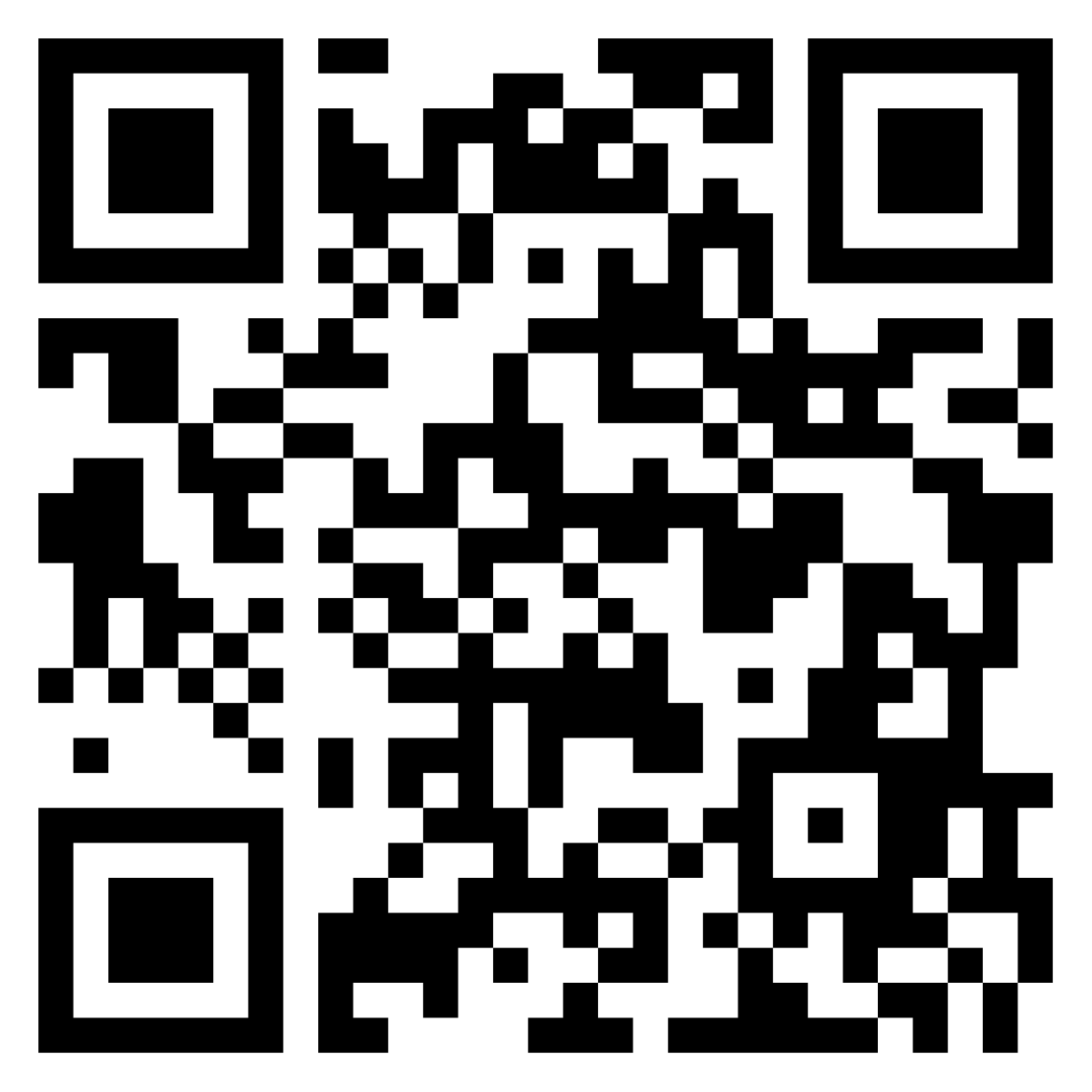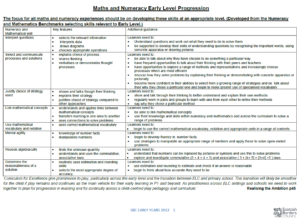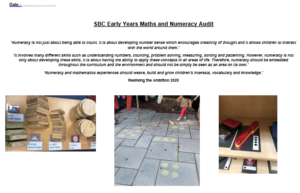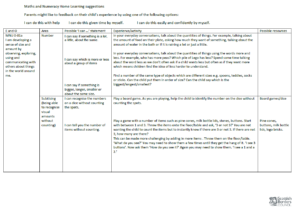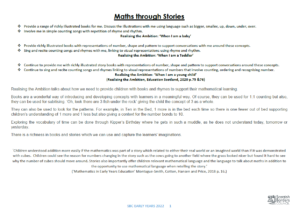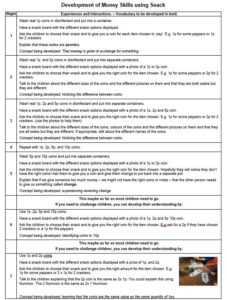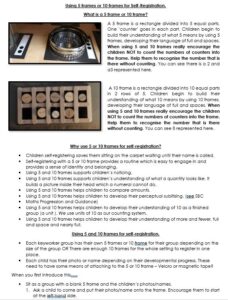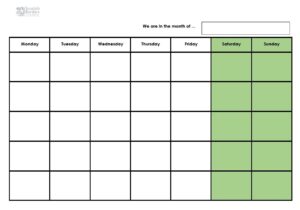Mathematics and Numeracy
What is it?
Mathematics has no formal definition. It is much more than studying numbers and counting, which we think of as mathematics today. Dr Liaqat Khan, Professor in Mathematics at Quaid-i-Azam University, Islamabad, says, “Mathematics is… concerned with… using imagination, intuition and reasoning to find new ideas and to solve puzzling problems”.
(Khan, 2015)
It is involved with developing an understanding of numbers, counting, measuring, sorting and patterning through exploration, creativity and problem-solving.
Numeracy is a small part of mathematics concerned with numbers, counting, and application.
Key messages:
- Positivity: Practitioners display positive attitudes towards mathematics and numeracy (learning dispositions and growth mindset).
- Knowledge and Understanding: Practitioners have a secure knowledge and understanding of early mathematics and how children develop this.
- Using Research: Research-based, up-to-date practitioner knowledge is demonstrated through the use of robust observations, use of progression pathways and trackers (see tabs at the bottom of this page).
- Mathematical thinking in Play: Children are provided with opportunities throughout the curriculum and the environment to develop mathematical thinking through play, using the skills derived from the Benchmarks for Early Level (Education Scotland, 2017).
- Interpret questions
- Select and communicate processes and solutions
- Justify the choice of the strategy used
- Link mathematical concepts
- Use mathematical vocabulary and notation
- Mental agility
- Reason algebraically
- Determine the reasonableness of a solution
- Problem-solving: Practitioners give children opportunities to solve problems in creative ways, exploring their ideas, allowing them to struggle, make mistakes and talk in-depth about their thinking.
- Developing knowledge and understanding: Practitioners provide children with opportunities to develop their knowledge and experience of patterns throughout the environment.
- Meaningful experiences in mathematics: Practitioners enable meaningful, relevant, daily mathematics experiences for children. Practitioners provide daily opportunities, invitations and provocations for children to experience and talk about quantities, patterns, shapes, symmetry, positions, sorting, size and numerals (For additional ideas, see mathsthroughstories.org and Block Play).
- Modelling maths and numeracy: Practitioners model and develop children’s abilities to notice the same and different. Practitioners understand the potential maths and numeracy learning in all areas of provision, indoors and out. Practitioners provide experiences, invitations and provocations using real-life objects (concrete materials) for children to explore and develop their mathematical thinking.
- Maths and numeracy beyond the setting: Practitioners provide regular opportunities to explore maths and numeracy beyond the setting, e.g. in the local community and at home.
- Family involvement: Practitioners discuss with families ways that they can support Maths and Numeracy learning at home.
Ways we can do this:
Positivity: Practitioners always talk positively about mathematics, their experiences of maths and display positive attitudes towards maths and numeracy even if it’s not necessarily their reality.
Knowledge and Understanding: All practitioners engage in professional learning about maths and numeracy, e.g. SBC Early Years training, SEAL Training (SEAL Learning and Teaching Sheets), Creative Star, Karen Wilding Early Years Maths, nrich and youcubed.
All practitioners use the SBC Mathematics and Numeracy Progression(see below) to support their knowledge and understanding of maths and maths pedagogy.
Using Research: Practitioners understand and use the progression pathways to plan appropriate next steps in learning for all pupils. Practitioners evidence pupil learning in numeracy and maths using SBC Mathematics & Numeracy Early Level Tracker (see tabs at the bottom of this page) and observations in Floorbooks and learning journeys.
Mathematical thinking in play: Practitioners use the first page of the SBC Mathematics and Numeracy Progression (see below) to develop their knowledge and understanding of supporting this. All practitioners use quality interactions that seize opportunities to skillfully develop mathematical vocabulary and knowledge, e.g. modelling, encouraging, facilitating and verbalising, during play situations.
Problem-solving: Practitioners model verbalising their thinking to the children when problem-solving, e.g. strategies for doing a jigsaw or measuring out quantities for playdough.
Practitioners ask open questions or ‘I wonder…’ comments to encourage children to persevere. Practitioners wait and watch to allow children to struggle and achieve solutions in their own way while supporting children to justify their thinking and ask questions about mathematical experiences (making learning visible and sustained shared thinking).
Developing knowledge and understanding: Practitioners support children to recognise and verbalise patterns as regularity of structure or relationships, e.g. alternating colours or the repetition of numerals when counting in 2s, the cycle of the days of the week or months of the year.
Practitioners provide opportunities for children to copy, continue, and create their own patterns using multiple materials, numbers, and mark-making resources.
Meaningful experiences in mathematics: Practitioners model finger counting and rhymes (finger rhymes also support the development of finger discrimination) through routines, rhymes and songs, and play. Borders YMI Early Years Youtube Channel and using music to support maths learning blog.
Daily stories, songs and rhymes explore various mathematical concepts and language, e.g., Goldilocks and size.
Maths is used in everyday routines, e.g. self-serve snack and lunch menu, visual choices, self-registration, tidying up (sorting and matching), following a sequence in a process, e.g., dressing for outdoor play or visual timetable of the day.
Practitioners provide open-ended resources to give opportunities for children to problem-solve, e.g. loose parts, block play, construction, marble run, domino rally.
Modelling maths and numeracy: Practitioners model by verbalising what they have noticed in the environment and stories and rhymes, e.g. ‘Look, there are 4 sheep in the picture, 1 under the tree and 3 by the gate.’ (subitising) or ‘I have noticed that all these shapes have straight sides, but this one has a curved side’ (properties of shapes).
- Practitioners notice and point out patterns on clothing, outdoors, numbers, shapes, colours as part of everyday conversations and experiences.
- Practitioners notice and point out that the quantity is the same but in a different arrangement; this is subitising.
- Practitioners notice and point out that all rectangles have 4 sides but that 2 are different lengths.
Practitioners create a maths rich environment both indoors and outdoors through: Using Early Years Maths and Numeracy Audit (see tabs at the bottom of this page).
to reflect on different areas of provision and how they can be improved.
Providing manipulatives such as 5 and 10 frames, number tracks, Numicon, Cuisenaire rods, counters, unifix cubes, dominoes, fingers and dice. In addition, 10 frames can be used for self-registration, using cubes for children to vote for the story of the week, using number candles in the playdough, using age birthday cards to make a number line.
Practitioners provide weighing scales, ‘real’ coins, measuring tapes, calculators to promote curiosity and exploration.
Providing opportunities to engage with maths in ‘real-life purposeful contexts’, e.g. baking and role play areas such as a café, telling the time, measuring, building a model, sorting washing.
Practitioners use knowledge of pupil interests and need to enhance continuous provision and support the development of maths skills.
Use maths and numeracy outdoor learning ideas (see print-outs below).
Maths and Numeracy beyond the setting: Children experience maths and numeracy in the wider world through a combination of:
-
- Numeracy and Maths walks with a particular focus, e.g. looking for patterns in nature, numbers, shapes, or signs in the local area,
- Going to the shops,
- Travelling on a bus,
- Noticing on outings into the community.
Family involvement: Practitioners discuss ideas with families of ways that they can support maths and numeracy learning at home:
-
- Using social media and learning journeys to share examples of learning in maths and numeracy with parents
- Read Write Count
- Parentzone Scotland
Linked Areas of Practice
Assessment
Block Play
Closing the Gap
Curriculum
Learning Journeys
Learning Dispositions (Learning Powers)
Loose Parts
Observations
Sensitive Interactions
Spaces
Science, Technology, Engineering and Maths (STEM)
Maths & Numeracy Trackers (SBC)
Tools
Reflecting on Practice
SBC Guidance to support
National Guidance to support
Further Reading to support
Training to support
SBC Early Years training video What is Early Numeracy?:
Follow link for acronyms used in presentations
See below for supporting materials
To see all the SBC Early Years training videos visit:
- SBC Maths and Numeracy Tracker Early Level
- SBC Maths and Numeracy Planning Progression & Guidance
- SBC Maths and Numeracy Audit Early Level
- Supporting Numeracy at Home SBC
- Outdoor Maths and numeracy adult-initiated experiences
- Maths and Numeracy Home Learning suggestions
- Maths Through Stories
- Supporting Materials – What is Early Numeracy? Training
- Music & Songs to support Early Numeracy (Youth Music Initiative in SBC)
- Clock/timer app to support learning
- Sketches school to support symmetry
- Money for Snack Progression
- Using 10 frames for self-registration
- Calendar Template
Kids Who Count with Their Fingers Are Smarter
Karen Wilding Education Ltd Developing True Mastery in Number Sense

